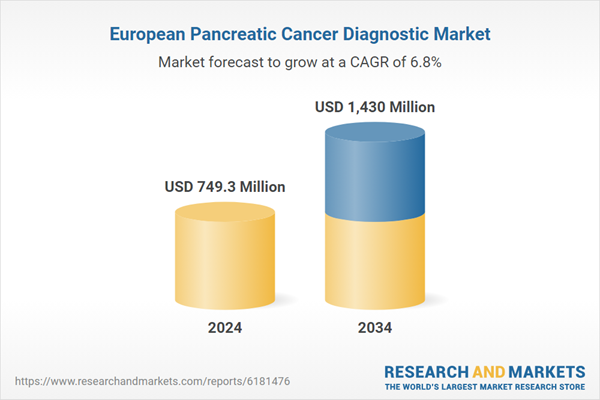The growth trend is driven by the increasing incidence of pancreatic disorders, continuous advancements in diagnostic technologies, higher healthcare spending, and rising awareness through early screening efforts. Since pancreatic cancer is often detected in later stages due to a lack of early symptoms, there is a growing focus on early diagnosis and precision-based testing methods. Healthcare providers across Europe are integrating more accurate, non-invasive, and high-sensitivity diagnostic tools into their systems. These include imaging-based modalities, molecular diagnostics, and biomarker-driven tests. Favorable regulatory initiatives and rising public health awareness are also enhancing access to modern diagnostic services. In addition, significant investment from both public and private sectors in healthcare infrastructure is helping accelerate early detection efforts for high-fatality diseases such as pancreatic cancer. Countries in Europe are prioritizing early-stage detection and personalized medicine, supporting the shift toward more effective diagnostic solutions tailored to individual patient profiles. These changes are creating strong opportunities for innovation and expanding the footprint of advanced diagnostic products across the European landscape.
In 2024, the consumables segment generated USD 427.8 million and is projected to grow to USD 804.6 million by 2034, registering a CAGR of 6.6%. The high demand for consumables stems from their critical role in a variety of diagnostic applications, especially molecular testing and liquid biopsy. These include reagents, buffers, and assay kits used in advanced technologies like immunoassays, image-guided biopsies, and next-generation sequencing. As diagnostic laboratories and research centers increasingly adopt precision testing platforms, the need for high-quality, scalable consumables continues to rise.
The imaging tests segment held a 60.9% share in 2024. Imaging remains a cornerstone in pancreatic cancer diagnostics due to its ability to provide non-invasive, real-time anatomical insights. These modalities are vital in identifying tumor presence, mapping disease progression, and assisting in treatment planning. Since the pancreas is located deep within the abdominal cavity, these imaging techniques offer a reliable means to assess tumor size, stage, and spread without requiring invasive procedures. Advanced imaging systems offer clinicians precise visualization, which is key for diagnosis and therapeutic decisions.
Germany Pancreatic Cancer Diagnostic Market generated USD 156 million in 2024. The country is witnessing a rising number of pancreatic cancer cases, with the disease ranking as a major cause of cancer-related deaths. Due to the disease’s typically late diagnosis and rapid progression, there is a heightened need for advanced and efficient diagnostic tools. As Germany continues to face an increasing patient burden, demand is rising for technologies capable of early detection and accurate cancer staging, further stimulating market expansion within the country.
Key companies operating in the Europe Pancreatic Cancer Diagnostic Market include Thermo Fisher Scientific, GE Healthcare, Olympus Corporation, Hitachi, Abbott Laboratories, Danaher Corporation, Canon, Siemens Healthineers, F Hoffmann-La Roche, Myriad Genetics, Illumina, QIAGEN, Agilent Technologies, Boston Scientific Corporation, Esaote, Koninklijke Philips, Becton, Dickinson and Company, and Sysmex Corporation. Leading players in the European pancreatic cancer diagnostics market are pursuing targeted strategies to bolster their competitive edge. Companies are investing in R&D to advance biomarker discovery, develop non-invasive liquid biopsy tests, and enhance imaging software for earlier cancer detection. Strategic collaborations with research institutes and clinical centers are helping accelerate technology validation and clinical adoption. Several firms are expanding their presence through partnerships with hospitals and diagnostic labs to offer integrated diagnostic solutions.
Comprehensive Market Analysis and Forecast
- Industry trends, key growth drivers, challenges, future opportunities, and regulatory landscape
- Competitive landscape with Porter’s Five Forces and PESTEL analysis
- Market size, segmentation, and regional forecasts
- In-depth company profiles, business strategies, financial insights, and SWOT analysis
This product will be delivered within 2-4 business days.
Table of Contents
Companies Mentioned
The companies profiled in this Europe Pancreatic Cancer Diagnostic market report include:- Abbott Laboratories
- Agilent Technologies
- Becton, Dickinson and Company
- Boston Scientific Corporation
- Canon
- Danaher Corporation
- Esaote
- F Hoffmann-La Roche
- GE Healthcare
- Hitachi
- Illumina
- Koninklijke Philips
- Myriad Genetics
- Olympus Corporation
- QIAGEN
- Siemens Healthineers
- Sysmex Corporation
- Thermo Fisher Scientific
Table Information
| Report Attribute | Details |
|---|---|
| No. of Pages | 90 |
| Published | October 2025 |
| Forecast Period | 2024 - 2034 |
| Estimated Market Value ( USD | $ 749.3 Million |
| Forecasted Market Value ( USD | $ 1430 Million |
| Compound Annual Growth Rate | 6.8% |
| Regions Covered | Europe |
| No. of Companies Mentioned | 19 |









